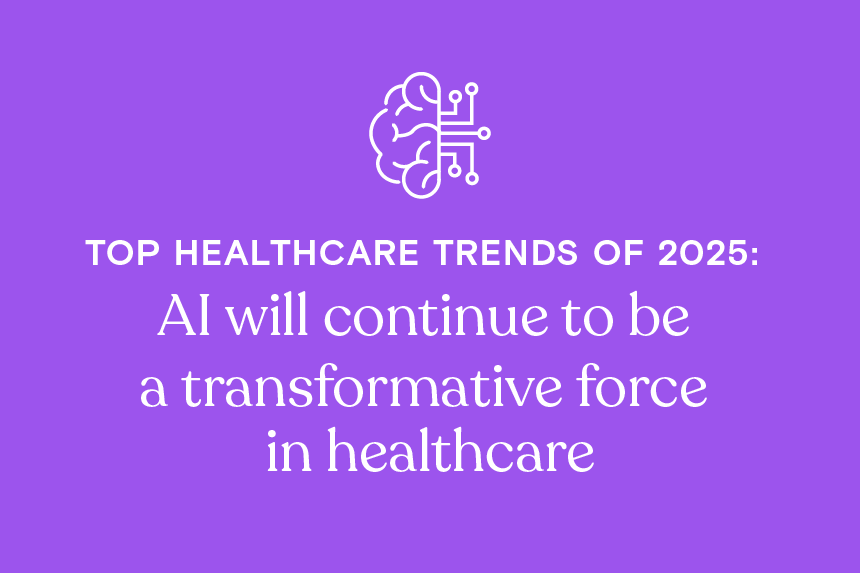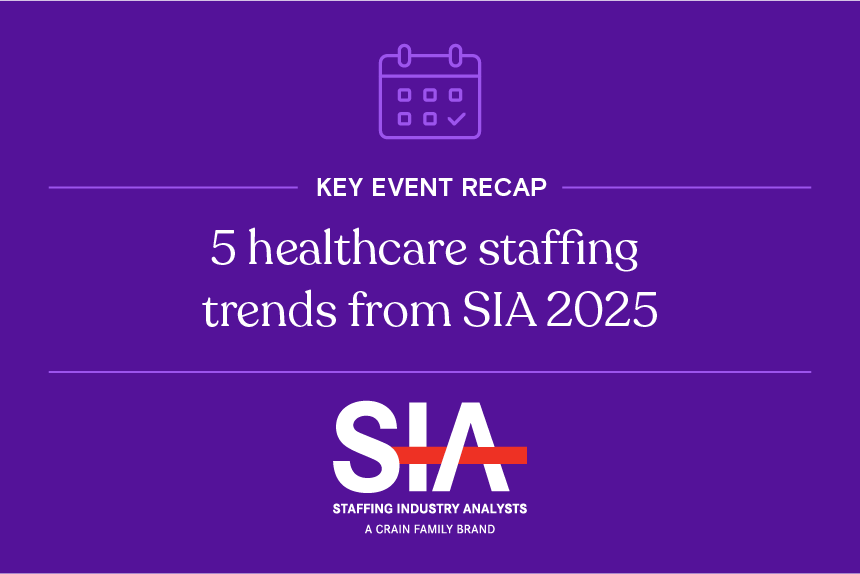Top healthcare trends of 2025: AI will continue to be a transformative force in healthcare
Oct 9th, 2024

There’s no doubt about it: artificial intelligence (AI) is changing everything. From finance to retail, transportation to entertainment, AI is transforming industries by automating complex tasks, uncovering new insights from data, enabling faster decision-making, and so much more.
The healthcare industry is no different—it’s nearly impossible to discuss the future of healthcare without mentioning the benefits, use cases, and consequences of AI. For good reason too: AI is enabling physicians to make more accurate diagnoses, create personalized treatment plans, and streamline operations. And that’s just in the provider space; the innovative potential for AI has spread all across the healthcare landscape, from life sciences organizations to manufacturers, suppliers, software companies, and more.
In this blog series, we’ll explore and analyze the top 2025 healthcare trends we expect to define the industry. We’ll discuss how life sciences companies are stepping into the direct-to-consumer market, the spread of behavioral health urgent care clinics, the non-opioid pain management movement, and the sky-high costs of medical care.
Kicking off this series, let’s look at AI’s growing role in healthcare and the groundbreaking ways it’s set to transform the industry.
Notable AI use cases in healthcare
The healthcare industry is arguably one of the earliest adopters of AI and machine learning (ML) technologies. Years before innovations like ChatGPT, DALL-E, and Midjourney captured widespread public attention, healthcare organizations and life sciences companies were already harnessing AI models to drive advancements.
While true, AI’s footprint and impact in the late 2010s was relatively small, and technology was primarily used and pioneered by only the biggest pharmaceutical and medtech companies. This would change, practically overnight, when AI hit the mainstream in 2023. Since then, the flurry of acquisitions, collaborations, and investments has been staggering. Estimates value the global AI healthcare market to be $16 billion today and expect it to grow at a remarkable 40% CAGR to reach $173 billion by 2029. It’s clear that opportunity is out there, and healthcare providers and companies are rising to the occasion.
As we move into 2025, we can expect greater and more widespread adoption of AI, ML, and predictive analytics technologies in the healthcare market, bringing even more impactful changes across the industry.
Below are some of the most notable AI use cases that are already transforming healthcare and will continue to shape its future.
Supporting earlier disease diagnosis by mining unstructured data
It’s no secret that the healthcare industry generates a lot of data. In fact, RBC Capital Markets estimates that healthcare data accounts for approximately 30% of the world’s data volume and is expected to increase year-over-year.
According to data infrastructure company NetApp, about 80% of the healthcare data generated is unstructured—which means that it is undefined and not easily formatted for use in a database or analytics platform. Examples include medical images, clinical notes, and lab reports.
Unstructured data can be immensely valuable to healthcare professionals, as it often captures the severity of a patient’s health condition and even the nuances of their environment. Untangling this vast amount of data—and being able to recognize complex patterns—can be crucial for healthcare providers.
However, unstructured data is often complicated to deal with as healthcare organizations can amass it quickly and haphazardly, which can make analyzing the dataset for trends incredibly difficult and time-consuming.
AI tools can streamline the process and take the heavy lifting out of making sense of unstructured data, saving physicians and researchers valuable time.
For example, providers can use machine learning models to analyze historical data to identify high-risk patients, predict medication outcomes, and recommend more personalized treatments. AI can also assist medical imaging specialists with analyzing MRIs and CT scans to detect anomalies and make diagnoses faster and with greater accuracy, or even detect patterns humans might miss.
These systems support healthcare providers by offering faster diagnoses, reducing human error, and enabling earlier intervention for diseases like cancer, heart conditions, and neurological disorders.
Enhancing remote patient monitoring capabilities
Remote patient monitoring (RPM) devices are growing in popularity alongside AI, and it seems likely that medical device manufacturers and providers will continue to pair the two technologies thanks to the value they provide.
AI and ML technology can elevate RPM devices in a variety of ways, from tracking vital signs to analyzing trends in chronic conditions like diabetes and heart disease. These systems can monitor patients’ health data in real-time, and then alert users and their doctors to potential health risks before they escalate, possibly leading to faster invention. This is especially valuable in managing large patient populations, enabling more proactive and personalized care plans. Early intervention can also lead to significant savings by preventing unnecessary emergency room visits and reducing hospital readmissions.
RPM devices already offer health systems and providers a wealth of benefits (read our RPM intelligence report for more), so pairing them with AI seems like a natural fit.
Optimizing the medical supply chain with predictive analytics
The aftermath of COVID-19 spotlighted how fragile the medical supply chain can be. In the years since, health systems, manufacturers, suppliers, and distributors have turned to technology like AI and the blockchain to enhance efficiency, streamline processes, and keep the supply chain moving smoothly.
AI’s predictive analytics capabilities are helping healthcare organizations manage inventory more effectively by analyzing historical data, patient demand trends, and external factors like seasonal health patterns or global crises (such as pandemics). These insights allow providers and suppliers to anticipate demand, reduce waste, and avoid stockouts of critical medications and supplies.
Meanwhile, blockchain technology adds another layer of security and transparency to the supply chain by providing an immutable, decentralized ledger that tracks every transaction and movement of goods. This is especially crucial in healthcare, where the integrity of products—such as pharmaceuticals and medical devices—can directly impact patient safety. By using blockchain, stakeholders can verify the origin, authenticity, and condition of each product at every step of the supply chain. Counterfeit drugs, which are a persistent issue in global markets, can be identified and removed from circulation before reaching patients, thus reducing fraud and protecting public health.
Together, AI and blockchain integration provide end-to-end visibility across the supply chain. With a comprehensive understanding of every touchpoint, organizations can better manage their stock and distribution networks, potentially leading to higher-quality patient care and better outcomes.
Identifying patients for clinical trials with NLP and optical character recognition
Clinical trials offer pharmaceutical and medtech companies valuable information and can significantly impact decision-making and strategic planning. However, conducting a successful clinical trial can be a challenge, as many trials fail to find suitable candidates fast enough.
Some studies report that about 80% of clinical trials fail to meet their original enrollment deadline, and 55% of trials are terminated for failing to achieve full enrollment. This can lead to substantial financial loss for the company, and development delays for treatments or devices, among other consequences.
AI can help clinical trial researchers find the most suitable patients faster and with greater accuracy. For example, natural language processing (NLP) and optical character recognition (the process of converting an image of text into a machine-readable format) enable AI models to quickly read large datasets and parse for specific information to identify candidates that meet the trial’s specific criteria. This can significantly slash time spent screening candidates, like in one study that screened 90 breast cancer patients in only 24 minutes, a 78% reduction in time compared to the 110 minutes it took for a human coordinator. With more accurate and reliable patient data, researchers can conduct more effective clinical trials, potentially leading to a better end product.
Accelerating drug discovery with AI-powered simulations
In the pharmaceutical industry, AI will continue to prove instrumental in accelerating the traditionally slow, costly, and risky process of drug discovery and development.
With AI’s ability to mine vast amounts of data for insights, trends, and patterns, we can expect biopharma companies to use the technology, particularly in the early stages of drug development.
For example, scientists can use algorithms to analyze biological data to identify viable molecules and compounds with desirable properties to treat a specific disease. Then, the team can use AI-powered simulations to better understand disease mechanisms and identify potential opportunities for drug intervention. This helps pharmaceutical companies bring potentially safer, more effective therapies to market faster, possibly leading to better patient outcomes and driving more revenue.
Improving marketing and sales activities
The healthcare landscape is fiercely competitive, and it’s only going to become more difficult to stand out and make your voice heard moving into 2025. Having a robust marketing and sales strategy will be all the more important if you’re looking to find your ideal customers, bring new products or services to market, and identify opportunities to expand and generate revenue.
Moving forward, we expect more companies and providers across the healthcare industry to embrace AI—not only for the use cases described above but also because the technology can optimize their marketing and sales operations. Here are three ways that AI can help:
- Gain a deeper understanding of the market. AI can analyze sources like medical and prescription claims, affiliations and referral patterns, geographic and demographic data, and more to offer you a comprehensive look into the patients, providers, and competitors that matter to you.
- Improve omnichannel strategy. Organizations can use predictive analytics and machine learning to better understand how, why, and when customers, influencers, and decision-makers engage with their brand—and then meet them on the channels they use most.
- Find relevant KOLs. Medical affairs teams can use AI to identify the most valuable experts in their treatment area by analyzing social media metrics, speaking engagements, publications, and more.
Learn more
With 2025 on the horizon, artificial intelligence is positioned to be a driving force behind some of the most transformative changes in healthcare. From revolutionizing disease diagnosis and drug discovery to optimizing the medical supply chain and marketing and sales performance, AI is not only enhancing how healthcare providers operate but also improving outcomes for patients across the globe.
Interested in more AI insights? Check out our report on how life sciences companies use AI or our study on AI use cases for healthcare providers.
AI technology is also at the core of our healthcare commercial intelligence platform and supports the delivery of clinical and market data, analytics, and expertise that can help you make faster, more confident business decisions and improve patient outcomes. To see how our solutions can help you grow your business faster in 2025, start a free trial with Definitive Healthcare today.
In our next trends blog of this series, we’ll explore how some of the biggest players in the life sciences industry are taking steps into the direct-to-consumer market. Is it a risky gamble, or a tactical move to engage customers earlier? Stay tuned to find out!




